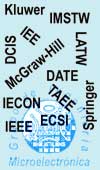
Mapa Web

Localización

Noticias

Info Santander

Gestión BD

|
| GIM>Investigación>Publicación |
| PUBLICACION |
| |
| Ficha completa |
| Título: | Theoretical fundamentals of functional verification based on random test benches |
| Tipo: | Publicacion en Proceedings o Actas internacionales |
| Lugar: | IEEE European Test Symposium ETS'05
Estonia |
| Fecha: | 2005-05 |
| Autores: |
Iñigo Ugarte
Pablo Pedro Sánchez
|
| Líneas: |
|
| Proyectos: |
|
| ISBN: | |
| Fichero: | ver fichero
|
| Resumen: | The latest releases of commercial verification tools often include coverage metrics and constraint-based generation of random test benches. This commercial interest may be provoked by several factors. Firstly, it seems that currently, the best method of functional verification automation is the coverage-driven random-based test bench generation. Secondly, designers show confidence in the results of random-based functional verification and there is even the impression that these test benches work better for verification than for test. This impression is mainly supported by practical experiences because although there is a huge amount of work on the theoretical bases of random testing, as far as we know, there is no similar work on functional verification. II. SYSTEM MODEL In this paper, we assume that the system is described at behavioral level as a set of statements that operate with integer data. Some basic operators are supported (addition, subtraction, multiplication, relational and logic operators) as well as ‘if’ control statements. Every execution path in the behavioral description can be modeled with polynomials (which model the system behavior) and a set of constraints, which model the if-statement conditions. The main goal of this paper is to explore theories that can analyze random-based functional verification methodologies. They are based on polynomial models of the system under verification and they provide fault-model independent coverage. |
|
|








